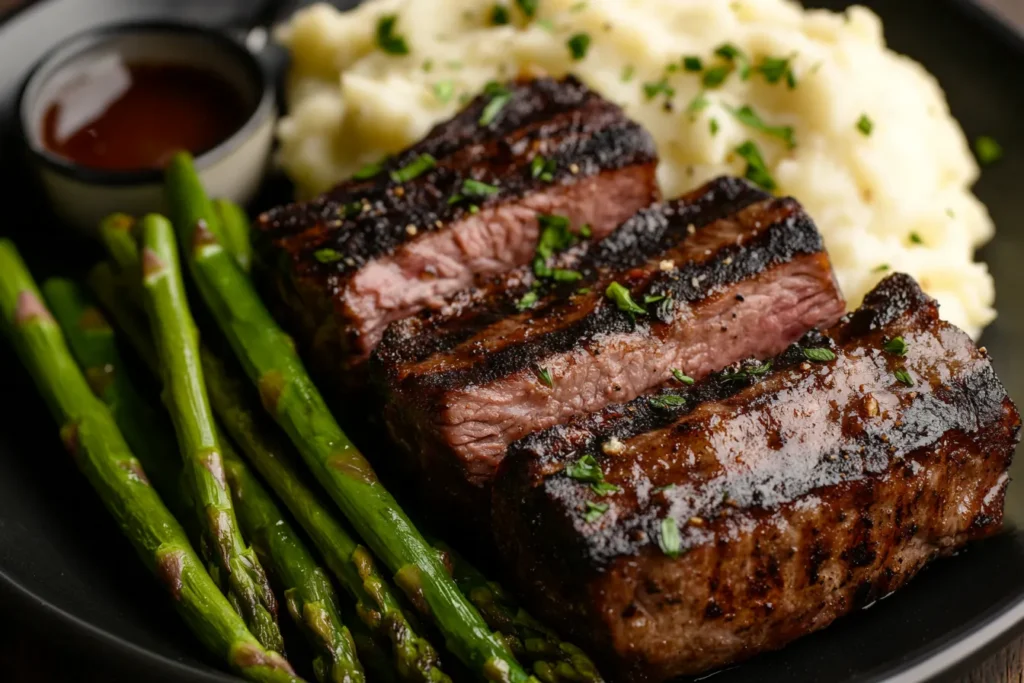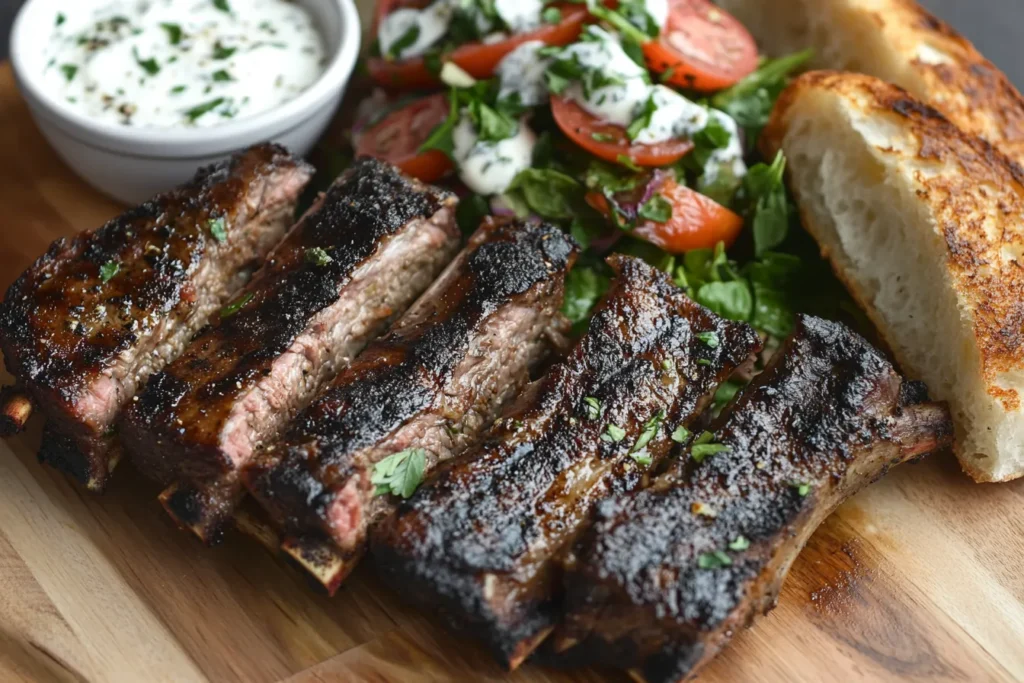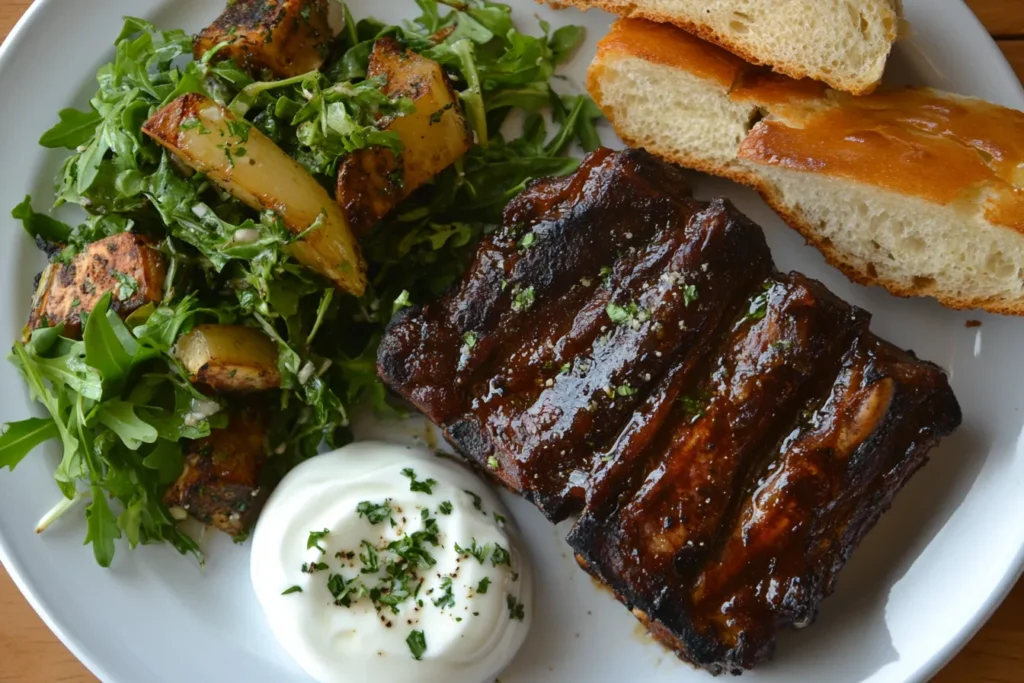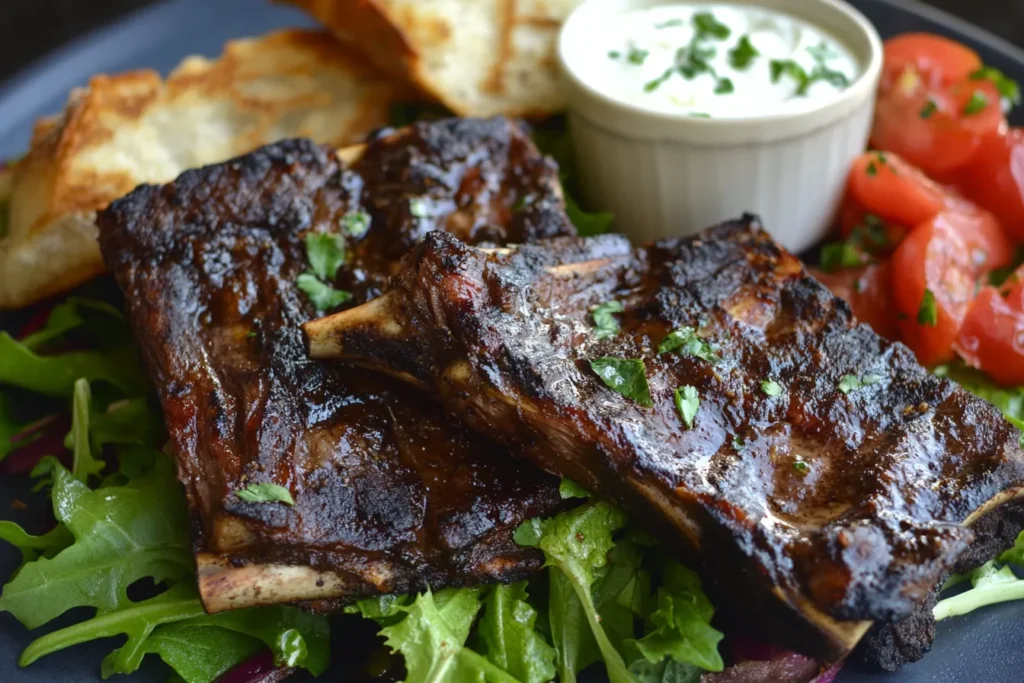Have you ever struggled to find a dish that’s both effortlessly comforting and impressive enough for a special occasion? Short ribs might just be the answer you’ve been looking for. With their melt-in-your-mouth tenderness and deep, savory flavor, they’re the ultimate crowd-pleaser. Whether you’re hosting guests or simply treating yourself, short ribs transform a simple meal into a culinary experience.
List Of Contents
What Are Short Ribs?
Short ribs are a cut of beef taken from the lower rib section. They combine the rich marbling of a ribeye with the hearty chew of brisket, making them perfect for slow cooking.
- Definition: Short ribs are meatier than traditional beef ribs, with ample connective tissue that breaks down during cooking.
- Variations: They come from different sections, like the chuck or plate, giving unique flavors and textures.
- Cuts: The two main types are English cut and flanken cut.
Different Types of Short Ribs
English Cut
- Cut along the bone, resulting in thick, rectangular portions.
- Ideal for slow cooking and braising.
Flanken Cut
- Thin slices cut across the bone, leaving small bone circles visible.
- Popular in Korean BBQ and quick grilling recipes.
Other Variations
- Boneless short ribs: Easier to work with but less flavorful compared to bone-in.
- Cross-cut ribs: A rarer variation used in specialty dishes.
Choosing the Best Short Ribs
Selecting quality short ribs is key to achieving the perfect dish. Here’s how to choose the best:
- Marbling: Look for well-marbled meat, as fat adds flavor and tenderness.
- Freshness: Opt for a bright red color with no grayish spots.
- Bone-In or Boneless: Bone-in ribs are more flavorful, while boneless options are easier to handle.
Why Cooking Time Matters

Cooking time directly impacts the texture and flavor of short ribs. Proper timing ensures:
- Tenderness: Short ribs require time to break down their connective tissue.
- Flavor Development: Slow cooking allows the rich, beefy flavors to intensify.
- Avoiding Overcooking: Too much time can dry out the meat, even with ample fat.
Key Factors Influencing Cooking Time
Several factors affect how long short ribs take to cook:
- Cut Thickness: Thicker cuts require more time for heat to penetrate.
- Cooking Method: Braising takes longer than grilling, while sous vide provides precise control.
- Desired Doneness: Cooking for tenderness requires more time than achieving a rare or medium-rare finish.
Preparing Short Ribs for Cooking
Preparation plays a pivotal role in how your short ribs turn out:
- Trimming: Remove excess fat but leave enough for flavor.
- Seasoning: Rub with salt, pepper, and spices to enhance flavor.
- Marinating: Let ribs soak in a marinade for at least 4 hours, or overnight, for optimal flavor infusion.
Equipment Needed for Cooking Short Ribs
Cooking short ribs requires the right tools for even heat distribution and flavor enhancement:
- Oven: Great for braising and roasting.
- Slow Cooker: Perfect for set-it-and-forget-it recipes.
- Grill: Adds a smoky, charred flavor.
- Stovetop: Ideal for browning and quick cooking.
The Role of Cooking Methods in Time Variation
Different cooking methods affect the required time and final result:
- Braising: Low and slow, producing tender, fall-off-the-bone ribs.
- Grilling: High heat for a caramelized crust, but requires careful timing to avoid drying out.
- Slow Cooking: Ensures consistent, even cooking over several hours.
Safety Tips for Handling Short Ribs
Food safety is crucial to ensure your short ribs are safe and delicious:
- Storage: Keep ribs refrigerated at or below 40°F (4°C).
- Defrosting: Thaw in the refrigerator, not at room temperature, to prevent bacterial growth.
- Internal Temperature: Cook to at least 145°F (63°C) for safety.
Benefits of Slow Cooking Short Ribs
Slow cooking is a game-changer for short ribs. It:
- Retains moisture, ensuring juicy results.
- Allows flavors to meld together for a richer dish.
- Breaks down connective tissues, making the meat incredibly tender.
For more slow-cooking tips, explore this comprehensive guide.
Methods and Timeframes for Cooking Short Ribs
Cooking short ribs to perfection involves choosing the right method and understanding the required cooking times. Whether you prefer the deep flavors of braised ribs or the smoky char of grilled ones, mastering the nuances of each technique is key. Check out more recipes here.
Braising Short Ribs: A Step-by-Step Guide

Braising is a slow-cooking method that yields rich, tender short ribs.
Steps to Braise Short Ribs
- Preparation:
- Trim any excess fat and season the ribs with salt, pepper, and spices.
- Lightly coat with flour to help form a crust when searing.
- Browning:
- Sear the ribs in a hot skillet with a bit of oil until browned on all sides.
- This step locks in the flavor.
- Cooking:
- Transfer to a Dutch oven or deep roasting pan.
- Add aromatics like onions, garlic, and herbs.
- Pour in liquid (e.g., beef broth, red wine, or a combination) until the ribs are half-submerged.
- Cover tightly and cook at 325°F (160°C) for 2.5–3 hours.
How Long to Braise Short Ribs
The braising time varies based on the cut and size of the ribs:
- Bone-In Ribs: 2.5–3 hours at 325°F (160°C).
- Boneless Ribs: Slightly shorter, around 2–2.5 hours.
Always test with a fork—the meat should easily pull away from the bone when done. Check out more recipes here.
Grilling Short Ribs: A Detailed Process
Grilling short ribs offers a smoky, charred flavor perfect for summer cookouts.
Steps for Grilling
- Marinate:
- Use a flavorful marinade with soy sauce, garlic, and sesame oil (popular in Korean-style grilling).
- Let the ribs marinate for at least 2 hours.
- Preheat Grill:
- Use medium-high heat for best results.
- Grill:
- Cook flanken-cut ribs for 3–4 minutes per side.
- For thicker cuts, sear on high heat, then move to a cooler part of the grill to cook through.
Grilling Times for Flanken-Cut vs. English-Cut Ribs
- Flanken-Cut: Quick to cook, needing only 5–8 minutes total.
- English-Cut: Requires 15–20 minutes, depending on thickness, with frequent flipping to avoid burning.
Slow Cooking Short Ribs for Perfect Tenderness
Slow cooking is ideal for busy days when you want a hassle-free meal.
Steps for Slow Cooking
- Preparation:
- Season and brown the ribs before adding them to the slow cooker.
- Cooking:
- Place ribs in the cooker with vegetables and liquid (like beef stock or barbecue sauce).
- Set to low for 8–10 hours or high for 4–6 hours.
Recommended Times
- Low heat: 8–10 hours.
- High heat: 4–6 hours.
How to Cook Short Ribs in an Oven
Oven cooking is a versatile method, allowing for both roasting and braising.
Oven-Braising Steps
- Preheat the oven to 325°F (160°C).
- Arrange ribs in a baking dish with vegetables and liquid.
- Cover with foil and cook for 2.5–3 hours.
Roasting
- Use a dry rub, then roast at 375°F (190°C) for 2 hours, flipping halfway.
Using a Pressure Cooker for Faster Results
Pressure cooking significantly reduces cooking time while maintaining flavor.
Steps
- Season and brown the ribs.
- Place in the pressure cooker with 1–2 cups of liquid.
- Cook on high pressure for 40–50 minutes, then allow a natural release for 10 minutes.
Benefits
- Cuts down cooking time by hours.
- Locks in flavors.
Sous Vide Short Ribs: Precision Cooking
Sous vide offers unparalleled precision, resulting in consistently tender ribs.
Steps
- Preparation:
- Season ribs and vacuum-seal in a sous vide bag.
- Cooking:
- Cook at 165°F (74°C) for 24–48 hours.
- After cooking, sear on high heat for a caramelized crust.
Why Sous Vide?
- Ensures perfect doneness.
- Retains maximum moisture and flavor.
Adjusting Cooking Time for Bone-In vs. Boneless Short Ribs

Bone-in and boneless ribs cook differently due to their structure.
- Bone-In Ribs:
- Take longer as the bone slows heat transfer.
- Best for slow cooking or braising.
- Boneless Ribs:
- Cook faster and are suitable for grilling or pressure cooking.
Adjust recipes accordingly to achieve ideal tenderness. Check out more recipes here.
Comparing Cooking Times Across Method
| Braising | 2.5–3 hours | Best for deep flavor and tenderness. |
| Grilling | 5–20 minutes | Ideal for flanken cuts or thin English cuts. |
| Slow Cooking | 8–10 hours (low) | Low and slow for maximum flavor. |
| Oven Cooking | 2–3 hours | Versatile and beginner-friendly. |
| Pressure Cooking | 40–50 minutes | Fastest method without sacrificing flavor. |
| Sous Vide | 24–48 hours | Precision-focused for perfect results. |
Enhancing Flavor and Serving Short Ribs
Mastering the art of cooking short ribs is only the beginning. To elevate your dish to restaurant-quality levels, you’ll need to focus on flavor enhancements, proper resting techniques, and presentation. This section explores how to perfect your short ribs and create an unforgettable dining experience. Check out more recipes here.
Ideal Seasonings and Marinades for Short Ribs
The right seasoning or marinade can transform short ribs into a culinary masterpiece.
Seasonings
- Classic: Salt, black pepper, garlic powder, and paprika.
- Herbs: Thyme, rosemary, and bay leaves for depth.
- Spices: Smoked paprika or chili powder for a smoky kick.
Marinades
- Asian-Inspired: Soy sauce, sesame oil, honey, and garlic (great for Korean-style ribs).
- Wine-Based: Red wine, olive oil, and herbs for braised dishes.
- Citrus and Spice: Lime juice, cumin, and coriander for a zesty, bold flavor.
Let your ribs marinate for at least 4 hours or overnight for maximum flavor.
The Importance of Resting Cooked Short Ribs
Resting is a crucial yet often overlooked step in cooking short ribs. Resting allows the juices to redistribute, ensuring each bite is moist and flavorful.
How to Rest Short Ribs
- Remove the ribs from heat.
- Place on a plate and loosely tent with foil.
- Let rest for 10–15 minutes.
This step is especially important for grilled or roasted ribs.
Signs Your Short Ribs Are Perfectly Cooked
Knowing when short ribs are done is essential for achieving the ideal texture and flavor.
Key Indicators
- Texture: Tender enough to pull apart with a fork.
- Internal Temperature: Should reach 190°F–205°F (88°C–96°C) for optimal tenderness.
- Appearance: A caramelized crust with juicy, well-cooked meat.
Use a meat thermometer to ensure accuracy.
Common Mistakes to Avoid When Cooking Short Ribs
Even experienced cooks can make errors when preparing short ribs. Avoid these pitfalls:
- Overcooking:
- Leads to dry, tough meat.
- Monitor cooking times carefully.
- Under-Seasoning:
- Results in bland flavors.
- Generously season the meat and the cooking liquid.
- Skipping the Sear:
- Misses out on flavor.
- Always sear ribs before slow cooking or braising.
Pairing Short Ribs with Sides and Beverages
The right accompaniments can elevate your short ribs to a complete gourmet meal.

Popular Side Dishes
- Mashed Potatoes: Creamy and rich, perfect for braised ribs.
- Roasted Vegetables: Carrots, parsnips, and Brussels sprouts add earthy tones.
- Polenta: A smooth, hearty side that absorbs the ribs’ juices.
Beverage Pairings
- Red Wine: Cabernet Sauvignon or Malbec pairs beautifully with braised ribs.
- Craft Beer: A stout or porter complements smoky, grilled ribs.
- Cocktails: Bourbon-based drinks enhance the meat’s caramelized flavors.
Leftover Short Ribs: Reheating and Storage
Leftovers can be just as delicious as the original dish if handled properly.
Storage Tips
- Refrigeration: Store in an airtight container for up to 4 days.
- Freezing: Freeze ribs in a sealed container for up to 3 months.
Reheating
- Oven: Warm at 325°F (160°C) for 15–20 minutes, covered with foil.
- Stovetop: Simmer gently in a small amount of liquid to rehydrate.
- Microwave: Use a lower power setting to avoid drying out the meat.
Cultural Variations in Short Rib Recipes
Short ribs are beloved worldwide, with distinct preparations in various cuisines.
Korean Galbi
- Flanken-cut ribs marinated in soy sauce, garlic, and sesame oil.
- Grilled over high heat for a smoky, caramelized finish.
American BBQ
- Smoked or grilled with a dry rub or tangy barbecue sauce.
- Served with coleslaw and cornbread.
European Braises
- Cooked in red wine with onions, carrots, and celery.
- Often paired with mashed potatoes or crusty bread.
Creating Short Rib Sauces: Techniques and Recipes
A well-made sauce can elevate short ribs from great to extraordinary.
Classic Sauces
- Red Wine Reduction: Simmer wine with beef stock, shallots, and herbs until thickened.
- BBQ Sauce: Sweet and tangy, perfect for grilled ribs.
- Gremolata: A mix of lemon zest, garlic, and parsley for a bright finish.
Tips for Making Sauces
- Use the drippings from the ribs for a rich, flavorful base.
- Reduce the liquid slowly to concentrate flavors.
- Adjust seasoning at the end for balance.
How to Plate Short Ribs for Maximum Appeal
Presentation is as important as taste, especially for a special occasion.
Plating Tips
- Stacking: Place ribs atop mashed potatoes or polenta for height.
- Garnishing: Add fresh herbs or a drizzle of sauce for color and flavor.
- Minimalism: Avoid overcrowding the plate to let the ribs shine.
Pairing thoughtful plating with your dish enhances the dining experience.
FAQs
1. Can I cook short ribs without searing them first?
Searing enhances flavor but isn’t mandatory for all methods, like slow cooking.
2. What’s the best cut for braising?
English cut ribs are ideal for braising due to their thickness and structure.
3. Can I overcook short ribs?
Yes, overcooking can dry out the meat, even with high-fat content.
4. What liquid works best for braising?
Beef stock, red wine, or a mix of broth and tomato paste are excellent choices.
5. How do I make short ribs less fatty?
Trim visible fat and cook the ribs a day ahead, then skim the fat off the chilled liquid.
6. Can I cook short ribs from frozen?
Yes, but cooking times will increase significantly, especially for braising or slow cooking.
7. Do short ribs shrink when cooked?
Yes, they shrink as fat and connective tissue render out during cooking.
8. Can I grill English-cut ribs?
While less common, English cuts can be grilled with proper marination and lower heat.
9. Are short ribs expensive?
Prices vary, but they’re often affordable compared to premium cuts like ribeye.
10. How do I make short ribs more tender?
Low and slow cooking methods like braising or slow cooking break down tough fibers, ensuring tenderness.
